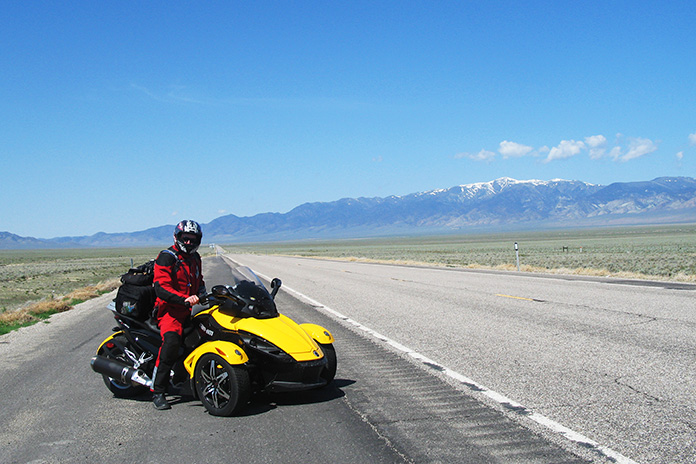
Feeling lonely? Having trouble getting noticed? Ride a Can-Am Spyder and you’ll instantly win friends and influence people. I’m not sure it would get you a date, though; stick with a Harley or Ducati for raw sex appeal. And stay away if you are self-conscious or misanthropic because the Spyder often draws a crowd. During my three-week, 2,600-mile test, giggly teenagers snapped cell-phone photos, drivers ogled while trying not to run off the road and curious folks peppered me with comments and questions.
Related: 2023 Can-Am Spyder RT Sea-to-Sky Review
The Spyder certainly is a novelty, but we took it seriously during our evaluation. When it arrived, I already had plans to visit family and attend Superbike races in Utah. I got a refund on my plane ticket, packed my gear and charted a scenic route from Southern California to Salt Lake City.
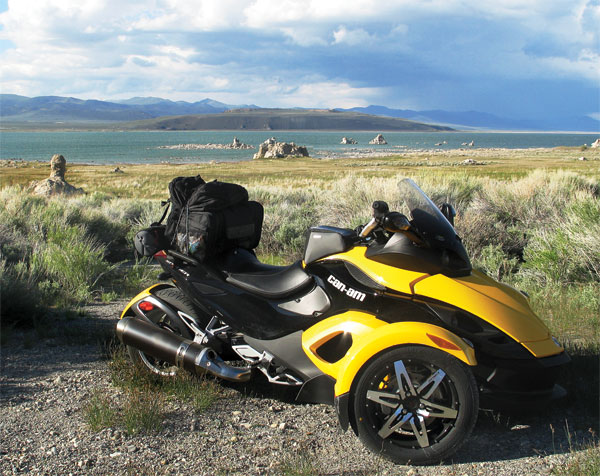
“What is it?”
Unlike sidecar rigs or trikes, which begin life as two-wheeled motorcycles and are transformed into three-wheelers, the Spyder was born a tripod. Built by Bombardier Recreational Products (BRP), a French-Canadian company well-known for its Ski-Doo snowmobiles, Sea-Doo watercraft and Can-Am ATVs, the Spyder takes elements of each of these machines and applies them to the street.
Some of you may dismiss the Spyder on general principle and have already begun writing letters vociferously explaining why it doesn’t belong in Rider. Fair enough. Rather than lure motorcyclists away from two wheels, BRP hopes to create a new market. During my tour, some motorcyclists I passed looked confused, trying to figure out whether I rated the brotherhood wave (Is he one of us?). Cage drivers, on the other hand, often gave me sympathetic, curious looks rather than the indifference or disdain often reserved for motorcyclists (Can I be one of them?).
“What’s it like to ride?”
You sit on the Spyder just like a motorcycle, and you hold on via handlebars and footpegs, shift with your left foot, operate the clutch with your left hand and twist the throttle with your right hand. But there is no brake lever; the right brake pedal operates disc brakes on all three wheels simultaneously, similar to a car.
Powered by a liquid-cooled, fuel-injected, 998cc 60-degree V-twin Rotax engine that generates a claimed 106 horsepower and 77 lb-ft of torque, the Spyder is lively if not exactly an arm-straightener (due in part to its hefty 840-pound wet weight). A smooth-shifting five-speed transmission also includes a reverse gear, activated by a lever on the left handlebar and dropping into gear below first. A steel center-beam SST (Surrounding Spar Technology–the three-letter acronyms have just begun!) frame locates the engine down low for better handling. Two 14-inch front wheels are held in place by a double A-arm (wishbone) suspension system common on race cars. Out back, the 15-inch wheel is suspended by a single shock; both front and rear are adjustable for preload. Each wheel has a 250mm disc, with four-piston calipers fore and a single-piston caliper aft. With automotive-style tires come automotive-size contact patches and lots of grip. Stomp on the brake pedal and the Spyder stops quickly and quietly, thanks to the wonder-twin powers of ABS and EBD (electronic brake-force distribution).
“If you are a motorcyclist, you must relearn how to turn,” warns the informative operator’s manual. Making the switch from countersteering to direct steering is intuitive; not leaning is what requires mental and physical adjustment. Unlike the we’re-in-this-together harmony of leaning a motorcycle, in curves I always felt at odds with the Spyder. Having high-sided myself off many a Jet Ski while cutting fast turns too sharply, I worried about doing the same thing on the Spyder with much less refreshing consequences. The VSS (Vehicle Stability System) is designed to prevent such drama with more acronyms: ABS, SCS (Stability Control System) and TCS (Traction Control System). When the Spyder’s steering sensor disagrees with the engine speed, rotation and wheel speed sensors, SCS limits engine power and, if necessary, brakes individual wheels. TCS cuts ignition and fuel when it detects rear-wheel spin.
“Where’re you headed?”
Touring is all about storage, and the Spyder is limited in this respect. Up front is a trunk with 44 liters of oddly shaped capacity: rectangular at the bottom, wedge-shaped at the top. Two full-faced helmets don’t quite fit. Accessing the trunk requires dexterity as you must push in the ignition key and turn it toward the luggage icon while simultaneously lifting the trunk lid. The only other storage provided was a small, optional tankbag. I used the optional, adjustable passenger backrest as a tie-down point for a large seatbag. A luggage rack would be welcome and may be among the additional accessories Can-Am will roll out in the fall.
Leaving home dark and early, I cruised down U.S. 101 and turned east on CA 126. Fertile farmland gave way to arid mountains as I headed northeast on CA 14 through the Antelope Valley. I felt pity for the phalanx of city-bound commuters nursing Prozac lattes in their hulking SUVs, fantasizing about $2-per-gallon gas.
Stopping for fuel and breakfast in the crossroads town of Mojave, I found that my luggage needs made filling up the Spyder a major pain in the coccyx. The front of the seat must be lifted up to access the fuel filler and a handy strut holds the seat up. When the seat is loaded with gear or a passenger, however, the strut can’t engage and I strained to hold the seat up with one hand and operate the pump with the other. Life would be easier if the fuel filler were on the side rather than under the seat.
Speaking of fuel, the Spyder proved to be very thirsty. The low-fuel light usually came on with about 130 miles on the tripmeter, and at most fill-ups I added five gallons. With 6.6 gallons of capacity, the low-fuel light indicates about 1.6 gallons of fuel remaining, which–based on my 26.8-mpg average (high of 33.2, low of 18.7)–translates to 43 miles before you start walking. The total estimated range is only 177 miles.
Just north of Olancha on U.S. 395, according to my fold-out map, is a big baby-blue expanse labeled Owens Lake. In reality it is a dull, gray salt flat. When I stopped for a photo, two fighter jets were sonic booming their way across the barren valley. Owens Lake ran dry in 1924, a decade after water from the Owens River was hijacked by the Los Angeles Aqueduct. The classic Jack Nicholson movie Chinatown fictionalizes some of the chicanery employed to ensure a steady supply of water to ever-expanding Los Angeles.
The snowcapped grandeur of the Sierras comes into full view at Lone Pine, a frontier town in the shadow of Mount Whitney, the highest peak in the lower 48 states (14,505 feet) and only 76 miles west of Death Valley (282 feet below sea level). Blue skies and mild temperatures made for ideal touring, but big mountains have a way of creating their own weather. After taking a short access road to Convict Lake just below Mount Morrison (12,614 feet), I rode through thick, gray fog and light rain. My micro-climate adventures continued on the 12-mile jaunt up CA 120 through Tioga Pass. As the narrow road snaked its way up to 10,000 feet, snow covered the roadside and surrounding peaks. Tioga Lake was frozen over and I encountered snow flurries.
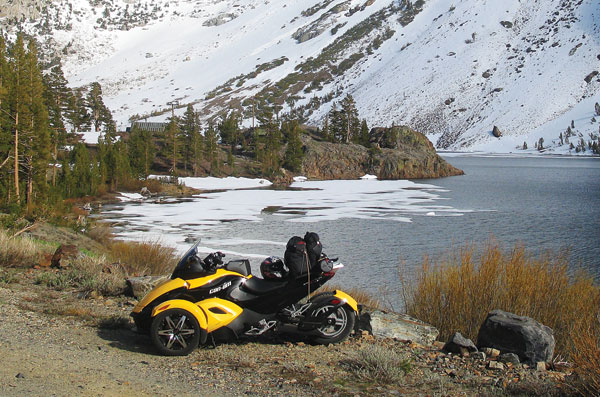
On my way back down, I followed a fast-paced pair of BMWs. This was my first sporting run through twisties, and I held the tank tightly with my knees as I leaned into the turns. Unless you muscle it, the Spyder understeers in fast curves. DPS (Dynamic Power Steering) adjusts steering effort based on speed, load and torque. Maybe so, but it still requires more work than a motorcycle.
After 550 miles on the road, I arrived in Carson City, Nevada. After checking into a cheap motel, I walked to Red’s Old 395 Grill for a pulled pork sandwich and a couple well-earned pints of Sierra Nevada IPA. Reflecting on the day’s ride, I was amazed at the comfort of the Spyder’s seat. My butt hadn’t bothered me all day. Although the seating position is upright and neutral, the low 29-inch seat height and high pegs cramped my legs after long stints in the saddle. The inherent stability of three wheels was much less demanding than two. After riding through gusty high-desert winds much of the day, I wasn’t as tired or sore as I would have expected. But, riding wasn’t as fun without leaning. Like most things in life, there is a trade-off.
“It looks fast!”
The next morning I traded U.S. 395 for U.S. 50 and a northerly direction for east. In 1986 Life magazine dubbed a 287-mile stretch of U.S. 50 from Fernley to Ely as the “Loneliest Road in America.” This designation is based on an interview with someone from AAA: “It’s totally empty–We warn all motorists not to drive there unless they are confident of their survival skills.” C’mon, it ain’t the Siberian Road of Bones! The longest stretch without gas is 112 miles, and I never went more than a couple of minutes without a car passing in the opposite direction.
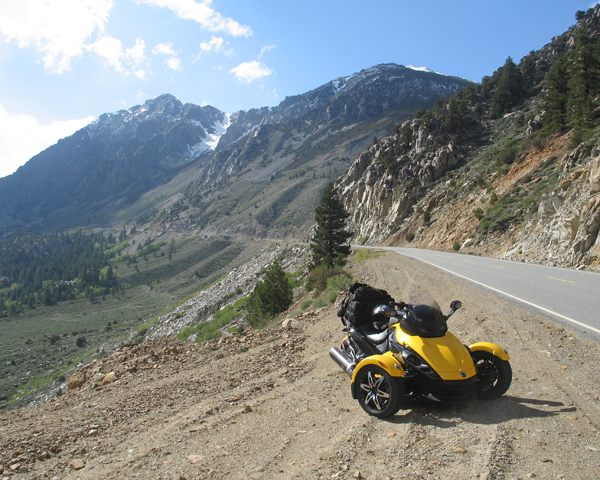
More than lonely, U.S. 50 is beautiful. It alternates between long, mostly straight sections across valleys and up-and-over canyon runs through the mountains. The long straights were perfect for top-speed testing. Tucked in behind the windscreen on a flat straight, the Spyder topped out at 115 mph. The tach needle wouldn’t go past 8,500 rpm, though, 1,000 shy of redline; clearly some electronic governing is involved. That the analog speedometer goes to 200 mph is either wildly optimistic, or it foreshadows a hot-rodded version in the future (it also has a digital speedo). Nonetheless, the Spyder is plenty fast and feels very stable at high speeds.
Having completed the Loneliest Road, I stopped for lunch in Ely, a town I’ve wanted to visit since watching Roadside Prophets. I continued on U.S. 50 to Baker and Great Basin National Park, where a twisting, slender road winds its way up to a 10,000-foot overlook of Wheeler Peak (13,063 feet). I was getting better in the curves, but still not as confident or comfortable as on two wheels. During sharp, fast turns, the stability and traction control systems often shut down the fun abruptly, like slamming into a harsh rev limiter.
Just east of Baker, I crossed into Utah. U.S. 50 traverses 88 desolate miles before reaching the town of Delta. After filling up, I took U.S. 6 northeast toward Salt Lake City. I had spent all day on lightly traveled roads in wide-open spaces, and my pace followed suit. Just outside of Eureka, a sheriff’s deputy going the opposite way flashed his lights. It had been almost 10 years since my last speeding ticket, so perhaps I was due. I can’t say for sure that the curious-looking Spyder with Quebec plates got me out of a ticket, but the deputy gave me a pass. Being polite and not a fugitive certainly helps. I arrived in Salt Lake City after dark, with 675 miles traveled for the day and a total of 1,225 since leaving Ventura. The Spyder hadn’t skipped a beat.
“Spyders Invade Utah”
After sleeping in, I visited with my father on the patio over coffee. Coincidence #1: The cover story in the automotive section of the Salt Lake Tribune was titled “Spyders Invade Utah,” the 3-wheelers having recently arrived in dealers. When I took turns riding family members around the mobile home park, many of the older residents looked dumb- founded as they witnessed the invasion of their community first-hand.
Before heading up to Big Cottonwood Canyon to shoot photos and video, the Spyder needed a bath. Coincidence #2: A block from my father’s place, Pinkie’s, a topless bar popular with bikers, was having a bikini bike wash to support the Peacemakers Motorcycle Club. I’m always happy to support charitable causes, and the tattooed ladies took a shine to the Spyder.
Working our way up the canyon, we ended up at Brighton Ski Resort for Coincidence #3: On a snow bank near the parking lot was a BRP Ski-Doo snowmobile. BRP has been making Ski-Doos for 50 years, and the family resemblance is striking.
On Sunday, the father-and-son adventures continued at Miller Motorsports Park in Tooele. After spending a few hours watching AMA and World Superbike races at the hot, dusty racetrack, we parted ways and I headed to Interstate 15 for the trip home. Lured by dozens of billboards promising $29.99 rooms and free breakfast, I made my way to the Oasis Hotel and Casino in Mesquite, Nevada. Arriving after dark, I checked in and headed to Tailgaterz Tavern for cheap wings and full-strength beer.
“So, how do you like it?”
The final leg of my trip would be 400 miles of scorching-hot freeway across the deserts of southern Nevada and California. After loading up at the breakfast buffet with dozens of elderly gamblers, I rode west to Valley of Fire State Park, a brightly colored sandstone canyon that became Nevada’s first state park in 1935. After misjudging a U-turn on a tight road, I buried the back wheel in soft sand. Two fellows stopped to offer help, and just before the heave-ho they asked me what I thought of the Spyder. By this time, I had been asked this question many times and I had plenty of experience to give a complete answer.
In a nutshell: The Spyder is a fun, unique machine. Most motorcyclists, particularly those who are performance-minded, will be left wanting. It has a pitbull of an engine, but the electronics (not to mention the weight) keep it on a tight leash. Powering out of tight turns brings a harsh rebuke from the Vehicle Stability System. On the highway, the Spyder is very comfortable and stable, but its limited storage capacity and poor fuel economy are barriers to serious touring. Accessory luggage and conservative riding will overcome this to some extent, but not entirely. I enjoyed my time on the Spyder, but like taking care of someone else’s child, I was happy to hand off the key and get back on two wheels.

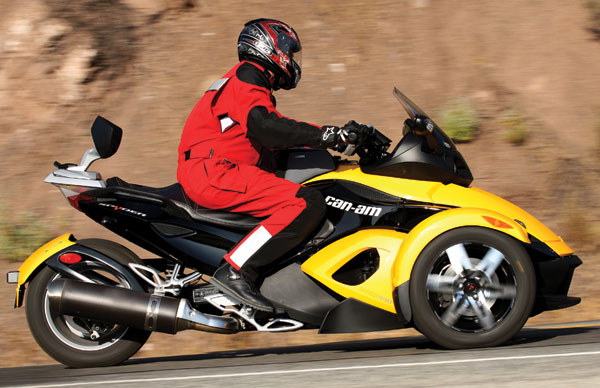
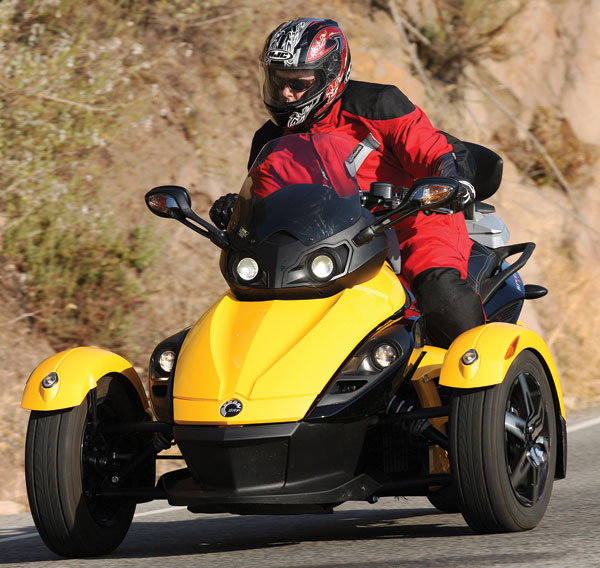

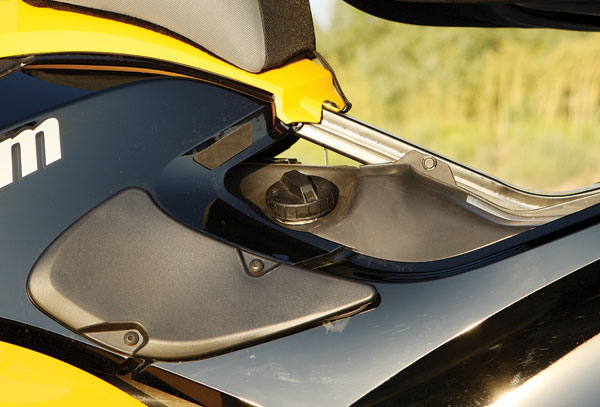
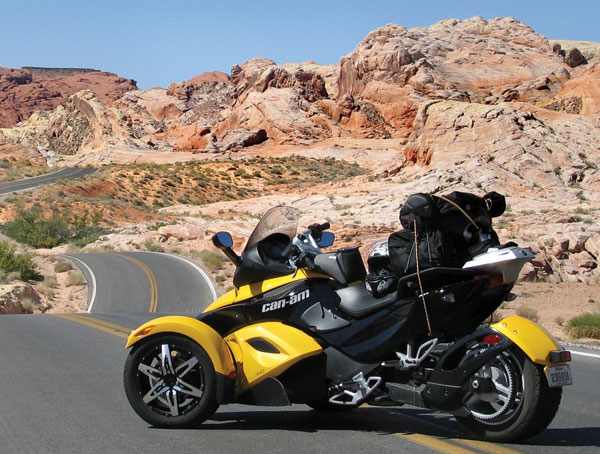
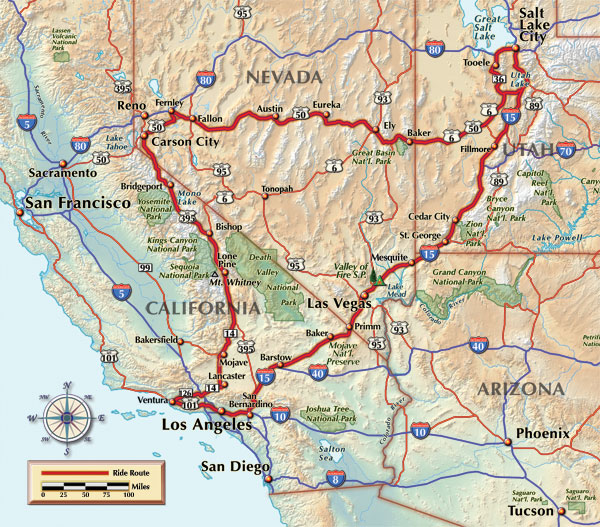







I recently (September 2015) purchased a used Yellow 2008 Spyder GS with less than 900 miles on it, yes it was essentially new! It had had no evidence of abuse. My reason for buying it was do to my age and more importantly, some heath issues, I found my ability to ride a Yamaha Venture Royale safely had all but disappeared, along with encouragement from my wife, who had been my passenger many times but had stopped, due to the above mentioned safety and ability issues, and our two sons, to take a test ride on the Spyder. A few days later I did and liked it. Realized that it greatly reduced or eliminated the issues I was facing riding a regular motorcycle. I made an offer and bought it the next day. Within a day or two my wife became my passenger again and took a couple rides with me. We put on nearly a thousand miles on it while vacationing in The Covered Bridge capital of the USA, Park County Indiana in October 2015. Yes I realize it is not a motorcycle, but for me it is pretty close and we have already spent some great ‘roadster’ time together on our Bumble Bee colored Spyder. Two of my close friends are giving consideration to the Spyder for about the same reasons I did.
someone local is selling an automatic 2008 can am spyder, 3510 miles, no accidents, for $800.
i’ve never driven a motorcycle nor really want to, but have always thought things like “trikes” were pretty neat.
i have nowhere to store other than a driveway (would have to tarp for winter in upper midwest probably).
is this something i should even consider? maybe no one will even see this, especially soon.
I don’t own one, but my husband is considering. We both have (two wheeled) motorcycles. I would recommend taking a 3-wheel riding course and see what you think. They do make covers for them, both OEM and aftermarket. Pick the brains of local dealers and riders too. Good luck!